
Ben Lindgren at Alice arts Center | Photo: Eleanor Lindgren
Double Bassist Ben Lindgren began his career in the late 1960s in a blues band, then in 1972 he began studies with renowned jazz bassist and composer Gary Peacock.
He played in jazz ensembles which featured both scored and improvised music, and he believed in developing new musical forms which push the boundaries of self-expression.
He performed and made two European tours with the Glenn Spearman Double Trio, a group he co-founded, and with whom he recorded two CDs for the prestigious Black Saint label.. He played with innovative saxophonist Charles Gayle and toured with saxophonist John Tchicai in a trio which included drummer/percussionist Spirit. He played with Prince Lasha and Eddie Gale.
His performances included concerts at the Victoriaville Festival Musique, the du Maurier International Jazz Festival in Vancouver B.C., Yoshi’s Jazz House, the Great American Music Hall, Slim’s, the Monterey Jazz Festival, Mills College, the Nickelsdorrf Austria Jazz Festival, and European tours in Zurich, Basel, Cologne, and Munich.
With OPEYE, with whom he played and recorded beginning in 1995, he included piano and National steel guitar in his repertoire in addition to doublebass.
For three years (1987-90), Lindgren was Assistant Music Director at Pacifica radio station KPFA-FM in Berkeley, working with Director and composer Charles Amirkhanian on musical projects that included such distinguished artists as John Cage, Phillip Glass, Laurie Anderson, Brian Eno, and Conlan Nancarrow.
From 1989-95, he produced Mob Ecstasy, a live music program on KPFA which featured studio performances by such players as Anthony Braxton, John Tchicai, Raphe Malik, Peter Apfelbaum, Karma Moffett, India Cooke, Beth Custer, Chris Brown, Bob Ostertag, J.A. Deane, and many more.
Ben Lindgren was a painter of note whose large oil canvases have appeared in galleries around the San Francisco Bay Area, including a one-man show in North Beach that was hailed by Beat Poet Gregory Corso. His work, which combines his “love of nature with the freedom of abstract expression”, has also been featured on the covers of several compact discs and regularly helped set the stage for OPEYE performances. His clients included friend and renowned bassist Charlie Haden.

Players playing at Ben’s Memorial, Chapel of the Chimes, Oakland: Doug Carroll, Larry Ochs, Oyulemi Thomas, John Gruntfest (seated, alto in hand), Henry Kuntz | Photo: Eleanor Lindgren

Eddie Gale | Photo: Georgette Gale

Brian Godchaux | Photo: Georgette Gale

John Gruntfest | Photo: Georgette Gale
BENJAMIN LINDGREN’S PAINTINGS by Jack Foley
I recently visited an interesting art gallery in Oakland. It’s called The Black Box (subtitled “a sacred technology project”) and is located at 1928 Telegraph Avenue, not too far from downtown. The director, Aaron Lane, is interested in the intersection of painting and sculpture with other arts, and his openings have featured music and poetry.
My visit was prompted by a Tribute to Benjamin Lindgren (1947-2002): an exhibition of six Abstract Expressionist paintings by Lindgren and a film, See What You See—Ben Lindgren’s Paintings, based on the six paintings. The film was made by filmmaker/musician David Michalak. (A few of Michalak’s other films were also shown, as was the great experimental film, The Fall of the House of Usher, made in 1928 by James Sibley Watson and Melville Webber: that film is often referred to as “the first American experimental film.”)
I knew Ben primarily as a musician: he was a fine free jazz bassist and played other instruments as well. I had often seen his paintings on display in his studio, a pleasant, airy, light-filled place featuring a couch, Ben’s easel and some interesting books, mostly but not exclusively about art. The paintings were at once easy, familiar objects and visionary tokens of another world: once you looked at them, you were projected into an odd, mythical space, very different from the studio itself. At the time I visited Ben, Abstract Expressionism (or “AbEx”) as a “movement” was long gone, but that fact didn’t concern him in the least: it probably amused him to think that he was practicing—carefully and with great precision—an art most people thought of as “passé.” Ben had considerable wit and could be very funny, but he also had a kind of crusty, unmoveable “integrity”: a deep sense of what he was about as a person and an artist. It’s that integrity that shines forth from these paintings.
On his website, David Michalak tells how he happened to make the film about Ben. He had run into Ben’s son, Esten, who told Michalak that Ben had only six months to live. Michalak began to visit the artist and became enchanted by the paintings:
His spirits were high and I found myself getting very close to him in his final days. We played music and talked about our first meeting and all the movies we worked on together. He showed me his abstract paintings. I’d known him for years but had never seen them. Why? I thought people should be aware of this body of work; over 100 paintings! I got so inspired that I offered to make a film. Ben was thrilled by the idea. The filming process began with me dragging all kinds of equipment through his house.
Michalak comments, “Ben was so amazing in his acceptance of his fate”—which indeed he was. He was at times in considerable discomfort, but he spoke quite frankly about his situation. At some level, “dying” was simply a subject of interest to him, and he thought about it as he thought about everything else. One had the sense that he felt the strangeness of death as he felt the strangeness of living: Wow!
Michalak tells us that he wanted to call his film Ben Lindgren’s Paintings, “so people would be forced to say his name when referring to the film”:
Then I remembered what Ben had said when I asked him what liberties I could take filming his work. “See What You See,” was his answer. So I married the 2 titles for maximum effect: See What You See—Ben Lindgren’s Paintings.

Ben Lindgren | Axagoras Form | 1987
The six paintings, which range from 1987 to 1999, are as haunting, elegant, and rich as anything Ben Lindgren ever did. I was caught initially by the earliest, “Axagoras Form.” Anaxagoras was a Greek philosopher born about 500 BCE who believed that all matter was infinitely divisible and motionless until animated by mind. I wondered whether Ben’s title was a reference to him—and perhaps a pun on the musician’s term for an instrument, “axe.” Certainly the painting is both philosophical and, like everything Ben did, musical. What was striking was the way in which forms flowed into one another—merged and separated—and how much sheer movement the painting contained. We were kept constantly alert, interested. No individual “form” announced itself as a “subject”—there was no “my daughter’s dog Fido” here. It was the painting as a whole which engaged us and moved us through its swirling, infinitely contrapuntal forms. Not for nothing has work by Lindgren graced the covers of CDs by free jazz artists such Glenn Spearman and Anthony Braxton.

Ben Lindgren | Glacier Pitch | 1988
The other five paintings—one untitled, “Cosmic Implosion” (a particularly apt title!), “Glacier Pitch,” “Exotic Jumble of Architecture,” and “Primordial Now”—were equally powerful. As the title suggests, “Primordial Now” emanated a shimmering sense of peace and harmony. There was a deeply religious, even mystical aspect to Ben Lindgren’s consciousness—he was, technically, Russian Orthodox, but he was also very aware of his Alaska Native roots—and that comes through in much of this work, which deliberately moves away from this world into something “other”: an “implosion,” a “jumble.” Lindgren was part of a generation which experimented with hallucinatory drugs such as LSD, and that too plays a part here.
David Michalak’s film sees all this and plays with the paintings by focusing on various parts of them, seeing them in differing modes of light. Since Michalak is a musician as well as a filmmaker, I wondered whether he considered the six paintings as six “chords”—a given which could be used as a spur to improvisation. Film has been called the most “realistic” of media, but like Lindgren, Michalak deliberately moves us away from all that. One of the other films he showed was called Not Quite Right. Music for the films—always interesting, always apt—was provided by REEL CHANGE, a quartet featuring Andrew Voigt, David Slusser, Adam Hurst, and Michalak himself.
Ben Lindgren was a wonderfully elegant man for whom art penetrated every fibre of his being. (Anyone who ever received a letter from him remembers the beauty of his handwriting.) His considerable capacities as a musician—I’m not in his league, but I played with him a few times—are material for a separate essay. His paintings give out the deep glow of his consciousness—which is in fact their subject. The question he asked in painting after painting is What does my consciousness feel like? How can I paint what is simultaneously real and immaterial? His answers are rich and layered, elegant, and passionately imagined. Ben’s close friend, the great saxophonist Glenn Spearman, died a few years ago. On the night before his death, Glenn’s wife Shantee asked him, “Are you dying?” Glenn answered, “No.” That same answer might have been given by Benjamin Lindgren. These paintings—and David Michalak’s film—are part of the proof.

Ben Lindgren | Tropic Of Chaos | 2000
TUESDAY by Jack Foley
I had fasted from 8 p.m. last night for a blood test this morning. First I went to Copy Central in Berkeley to pick up copies of Mary-Marcia Casoly’s book, Run to Tenderness, but they had messed something up, so I’ll have to go again tomorrow morning. Copy Central opens at 7:30 a.m., and the advantage of going very early in the morning is that you can easily get parking spaces and don’t have to feed the meters, which begin at 9.Then, from downtown Berkeley, to Oakland—Kaiser hospital on MacArthur—for the blood test. I was taken in almost immediately. Unfortunately, the first—stab— failed to draw much blood, so it had to be done again on my other arm. Happily, the other arm was a fountain. I went around for most of the rest of the day with a piece of cotton and a bandage on both arms. After the blood test it was about 9 a.m. I needed a new screen for my electric razor. The shaver shop was on the way to the Russian Orthodox Church where Ben’s funeral was to take place. The visitation—viewing the dead person—began at 9:30. I took a chance that the shaver shop was open—and it was. I got into the car to go to the church, but felt a little hungry. Had no idea when I’d get some food. There was a café next door to the shaver shop. I ordered scrambled eggs and a bagel and some delicious iced tea. Satisfied, I went to the church (near Shattuck and Ashby). Visitation was still going on. I went over and looked at Ben. I knew many of the people there—many of them prominent Bay Area musicians. It was nice to see them. It was nice to see Ben, too—though I had seen him the night before. He was decked out in a black leather jacket and wore his wedding ring. There was a little drawer that was open above him in the coffin. It had a harmonica in it. Ben’s wife Ella told me that he had wooed her by playing the harmonica and telling stories. I had never heard him play harmonica but was sure it would hold him in good stead in the afterworld. Ella said the bass was too big and she wouldn’t let him have the guitar. Then came the service, which was nice, tasteful, but a little long. Ella told me that one of the priests had been born on the same day as Ben. The officiating priest, who seemed intelligent and scholarly, talked about the problems of language—English vs. Russian—and the various traditions that went into the service. There were Pagan elements, he said, and Jewish elements. Thinking, I’m sure, of the Neoplatonists, he mentioned that the Pagans thought of the body as a prison, and that the Jews thought of the body as corrupt. He felt that where his faith parted company with both the Pagans and the Jews was in the belief in the resurrected body. As Jesus had been resurrected in His body, so too would the dead be. The priest insisted that though he “didn’t know how,” we would “see Benjamin again.” Clearly a sensitive man, the priest struck me as someone who might well have gone into the church because of its emphasis on culture and art. The problem for me is that an immense amount of baggage goes along with that culture and art—and not least is the belief in the immense wonderfulness of God and the immense awfulness of man. Statements such as he made on that subject must surely have been made by the Catholic Church during its services. As a child, I simply took them in. Now, however, I feel much more inclined to argue. The art and culture are the sugar coating on the pill of a belief which is deeply, fundamentally repellant. And this, I’m sure, was a Berkeley lite version of Russian Orthodoxy! It’s important to assert the limitations of the ego sense—something Ben was aware of in his work—but self abasement? original sin? (The latter doctrine a clear misreading of the first book of Genesis. I thought of the English writer Philip Pullman, who was right to focus on original sin in his Dark Materials trilogy.) One of Glenn and Shantee Spearman’s daughters stood in front of me during the service, in which we all held lit candles. The little girl is, I don’t know, nine years old and has enormous energy, which will one day be a marvelous thing. At the moment, however, she is rather a caution. Eventually, the lit candle, which she was waving about a little, was confiscated from her and she was led into the room next door, where there were some other children. She was wearing a beautiful, rather Chinese-looking dress—probably of her mother’s choice—and she looked just wonderful. She has the kind of intensity Glenn had, and she is quite beautiful even now. Oh, when she grows up! At the end of the service, everyone gives the dead person a goodbye kiss. Ben was wearing a headband made of paper, with some religious designs on it; that’s what you kiss. I also touched his hand, which of course was cold. Then we drove to the Chapel of the Chimes on Piedmont in Oakland for the “entombment.” There was a “funeral procession” which I decided not to be part of, so I went on ahead by myself. The Chapel of the Chimes is a beautiful place, and Ben had chosen exactly where he would be interred—not too far from John Lee Hooker! More incense, a few more words, and the coffin was put in a big drawer in a wall. Then downstairs for food—a really excellent spread, delicious. I had two genuine chocolate chip cookies. I generally avoid the sugar-added, but this was special. For Ben. I chatted a bit with Charles Amirkhanian, a wonderful man—a composer—who coordinated music programming for many years at KPFA. He is currently running the Other Minds Festival in San Francisco. I knew many people in the room, so there was no problem finding people to talk to. Lyn Hejinian, whose husband Larry Ochs is a well-known local musician, was there. Next, everyone went into the next room. Ella welcomed everyone and thanked them from a podium with a microphone. Then people who wished to say something about Ben came up to the podium. Ben had worked for Charles Amirkhanian at KPFA, so Charles talked about that. I talked a little about the “Mob Ecstasy” program Ben and I had done with Glenn Spearman (I’m the only one of that trio left!) and then read the poem I wrote recently—the one which transforms itself once the news of Ben’s death (at 55!) reaches me. It’s a little as if the poem knew of Ben’s death even if I didn’t—or as if Ben were sending me a message through my words even as he lay dying: “and then / in the morning / out on the water / again.” Later, several people told me how much they enjoyed the poem. I’ve been complaining recently how hard it is, after a certain point, not to write elegies: so many of your friends die. How is it possible to register the impact of a person’s death without writing an elegy? I think my little poem is a partial answer to that question. After the testimonies, there was a concert—and what a concert it was! Something like seventeen of the most prominent free jazz players in the Bay Area came together for this: the piece, “For Ben,” was directed by Eddie Gale. Everyone improvised, but there was a structure within which everything happened, and Gale indicated who should play next. Solo upon solo, always interesting, each quite different from the other. (One Irish guy, Jim Ryan, played a chorus of “Danny Boy”!) Finally everyone stood up and played together. There was a huge blast of sound in which you felt that Ben’s spirit was being sent off into the universe. It was really wonderful. The only negative thing about it for me was that Ben’s son Esten (who is 27 or 28) didn’t play in the group. Esten’s playing is probably still not the equal of the musicians in the group, some of whom are masters, but he would have done well enough, and it would have been a powerful emotional moment for everyone. I wondered whether Esten had been asked but declined, but, no, he told me he hadn’t been asked. Later, I told him that I wished he’d played. He nodded and said, “Look, this isn’t over.” I said, “No, it isn’t,” and hugged him. There was much hugging and few tears—not because Ben’s loss wasn’t a real one but because (despite th
e terrible, terrible suffering of his last days) tears was not what his life was about. “Life’s sweet, man,” he said to me in our last conversation, “it’s sweet.”
*
March 29, 2002
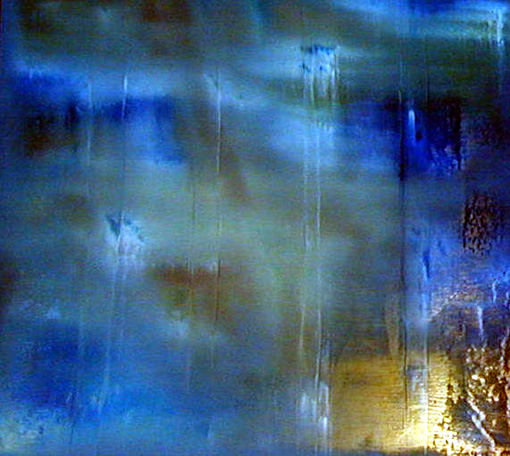
Ben Lindgren | Monterey Shroud | 1998
[My friend Mary Marcia Casoly is off on a kayaking trip. I wrote this poem to her—and then the phone rang and the poem took on another meaning.]
thinking of you in the wilderness “roughing it”
me here
in this troubled city
straining to meet
one obligation after another
thinking of you sleeping
under the stars
or waking on the water in no danger
yet watchful
as if you were walking in a bad neighborhood
making your way
from one place
to another
from one heart
to another among others
talking telling stories
playing word games
the poet among
adventurers
leading them
into adventures
which they would not have chosen showing them
wor(l)ds
they had not known—
and then
in the morning
out on the water
again
*

Ben Lindgren | Sarcos Ashes And Sand | 1998
The moment I finished writing this, the phone rang and I learned that my friend Ben Lindgren had died during the afternoon. I suddenly realized that the words I had just written might have a very different meaning:
leading them
into adventures
which they would not have chosen showing them
wor(l)ds
they had not known—
and then
in the morning
out on the water
again

Ben Lindgren | Exotic Jumble Of Architecture | 1999
…following a couple of Ben Lindgren images…

Shantee Spearman | Ben Lindgren | Photo: Eleanor Lindgren – 2000
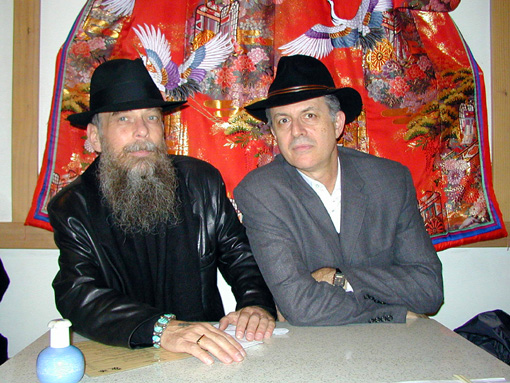
Ben Lindgren | Charles Amirkhanian | Photo: Eleanor Lindgren – 2001
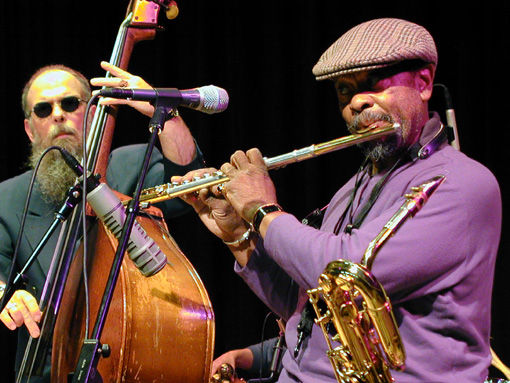
Ben Lindgren | Prince Lasha | Photo: Eleanor Lindgren – 2001

Ben Lindgren | Will Nichols | Photo: Eleanor Lindgren – 2001
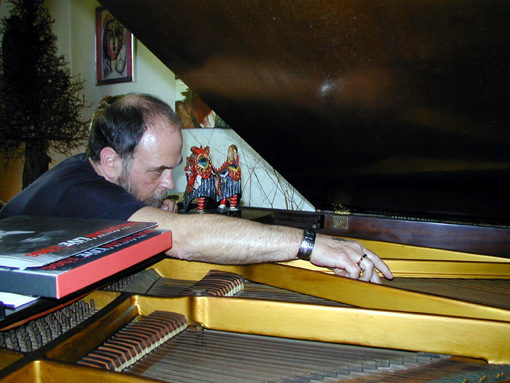
Ben Lindgren on Piano | Photo: Eleanor Lindgren – 2001

Esten and Ben Lindgren | Photo: Eleanor Lindgren – 2001
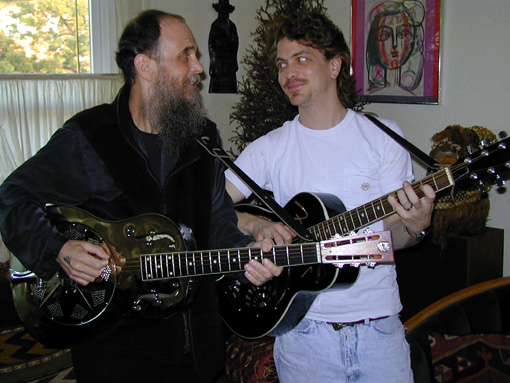
Ben Lindgren and Esten | Photo: Eleanor Lindgren – 2002

Ben Lindgren and Spirit | Photo: Eleanor Lindgren – 2002

Ben Lindgren | Photo: Eleanor Lindgren – 2002
